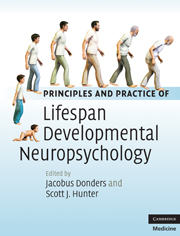Book contents
- Frontmatter
- Contents
- Contact information for authors
- Biography for Jacobus Donders and Scott J. Hunter
- Introduction
- Section I Theory and models
- Section II Disorders
- 5a Attention deficit hyperactivity disorder in children and adolescents
- 5b Attention deficit hyperactivity disorder in adults
- 5c Attention deficit hyperactivity disorder: a lifespan synthesis
- 6a Learning disorders in children and adolescents
- 6b Learning disorders in adults
- 6c Synthesis of chapters on learning disabilities: overview and additional perspectives
- 7a Infants and children with spina bifida
- 7b Adolescence and emerging adulthood in individuals with spina bifida: a developmental neuropsychological perspective
- 7c Spina bifida/myelomeningocele and hydrocephalus across the lifespan: a developmental synthesis
- 8 Cerebral palsy across the lifespan
- 9a Intellectual disability across the lifespan
- 9b Lifespan aspects of PDD/autism spectrum disorders (ASD)
- 9c Autism spectrum disorders and intellectual disability: common themes and points of divergence
- 10a Hearing loss across the lifespan: neuropsychological perspectives
- 10b Visual impairment across the lifespan: neuropsychological perspectives
- 11a Traumatic brain injury in childhood
- 11b Adult outcomes of pediatric traumatic brain injury
- 11c Neurobehavioral aspects of traumatic brain injury sustained in adulthood
- 11d Traumatic brain injury in older adults
- 11e Traumatic brain injury across the lifespan: a long-term developmental perspective
- 12a Pediatric aspects of epilepsy
- 12b A lifespan perspective of cognition in epilepsy
- 13a Leukemia and lymphoma across the lifespan
- 13b Lifespan aspects of brain tumors
- 14 Lifespan aspects of endocrine disorders
- 15 Metabolic and neurodegenerative disorders across the lifespan
- 16a Psychopathological conditions in children and adolescents
- 16b Psychopathological conditions in adults
- 16c Neuropsychological aspects of psychopathology across the lifespan: a synthesis
- Index
- Plate section
- References
11d - Traumatic brain injury in older adults
from Section II - Disorders
Published online by Cambridge University Press: 07 May 2010
- Frontmatter
- Contents
- Contact information for authors
- Biography for Jacobus Donders and Scott J. Hunter
- Introduction
- Section I Theory and models
- Section II Disorders
- 5a Attention deficit hyperactivity disorder in children and adolescents
- 5b Attention deficit hyperactivity disorder in adults
- 5c Attention deficit hyperactivity disorder: a lifespan synthesis
- 6a Learning disorders in children and adolescents
- 6b Learning disorders in adults
- 6c Synthesis of chapters on learning disabilities: overview and additional perspectives
- 7a Infants and children with spina bifida
- 7b Adolescence and emerging adulthood in individuals with spina bifida: a developmental neuropsychological perspective
- 7c Spina bifida/myelomeningocele and hydrocephalus across the lifespan: a developmental synthesis
- 8 Cerebral palsy across the lifespan
- 9a Intellectual disability across the lifespan
- 9b Lifespan aspects of PDD/autism spectrum disorders (ASD)
- 9c Autism spectrum disorders and intellectual disability: common themes and points of divergence
- 10a Hearing loss across the lifespan: neuropsychological perspectives
- 10b Visual impairment across the lifespan: neuropsychological perspectives
- 11a Traumatic brain injury in childhood
- 11b Adult outcomes of pediatric traumatic brain injury
- 11c Neurobehavioral aspects of traumatic brain injury sustained in adulthood
- 11d Traumatic brain injury in older adults
- 11e Traumatic brain injury across the lifespan: a long-term developmental perspective
- 12a Pediatric aspects of epilepsy
- 12b A lifespan perspective of cognition in epilepsy
- 13a Leukemia and lymphoma across the lifespan
- 13b Lifespan aspects of brain tumors
- 14 Lifespan aspects of endocrine disorders
- 15 Metabolic and neurodegenerative disorders across the lifespan
- 16a Psychopathological conditions in children and adolescents
- 16b Psychopathological conditions in adults
- 16c Neuropsychological aspects of psychopathology across the lifespan: a synthesis
- Index
- Plate section
- References
Summary
Introduction
Traumatic brain injury (TBI) in older adults poses a critical health problem, a statement which is supported by epidemiological studies indicating that persons aged 65 years and older are especially vulnerable. In the USA, the rate of TBI-related emergency room visits, hospitalizations, and deaths for the period 1995–2001 was 267.4/100,000 in persons aged 65–74 years. The figure for those 75 years and older dramatically increased to 659.1/100,000, and this group was found to have the highest rate of TBI-related hospitalizations and deaths compared to any other ages [1]. Analysis of data from a Centers for Disease Control and Prevention 15-state TBI surveillance system indicated that persons 85 years and older were twice as likely to be hospitalized as those 75–84 years, and more than 4-times as likely as those 65–74 years [2]. The above statistics are coupled with shifts in the percentage of older persons in the USA. Thirty-five million people were 65 years and older in the year 2000, representing a 12% increase over the past decade. This figure is projected to rise to 53 million in the year 2020, with the elderly comprising over 20% of the US population by the year 2030 [3].
In this chapter, we present research findings concerning the functional, cognitive, and emotional outcomes from TBI sustained in older adults.
- Type
- Chapter
- Information
- Publisher: Cambridge University PressPrint publication year: 2010



